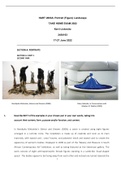Tentamen (uitwerkingen)
History of Art Exam : Portrait (Figure) Landscape
- Vak
- Instelling
Essay including Visual Analysis on Nandipha Mntambo, Silence and Dreams (2008), Mary Sibande, In Conversation with Madam CJ Walker (2009) , Zanele Muholi, Lerato Dumse, Faces and Phases series, Charlthes Davidson Bell, Hunting a White rhinoceros on the Crocodile River (1839), Mark Lombardi, Gerry...
[Meer zien]




